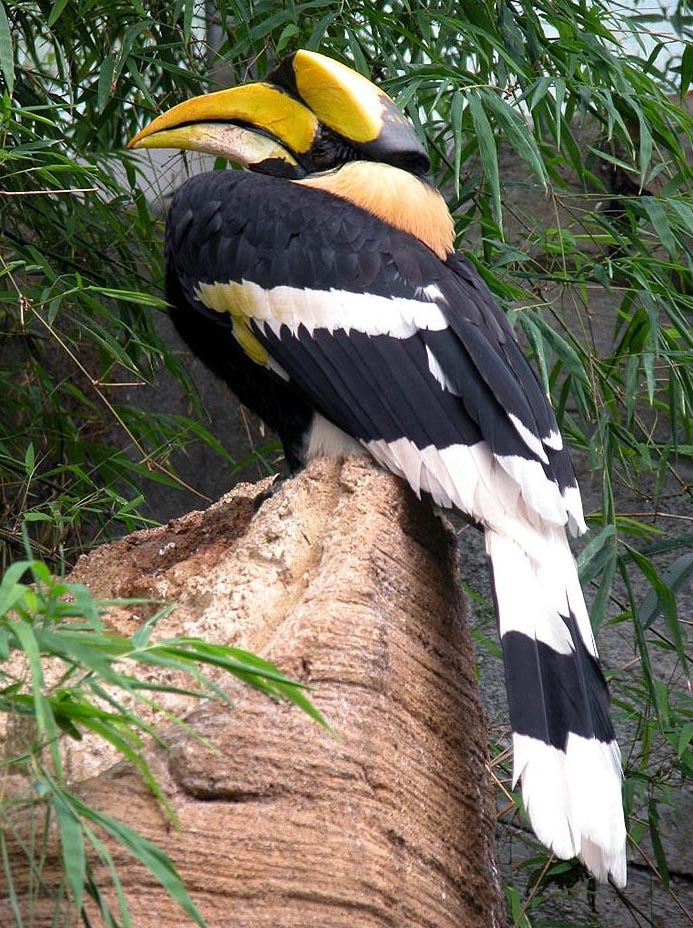Great Hornbill (Buceros bicornis) - Wiki Great Hornbill
From Wikipedia, the free encyclopedia
Order: Coraciiformes
Family: Bucerotidae
[Photo] Great Hornbill (Buceros bicornis) at the Cologne Zoo (Germany), Tropical House. Photographer: Wilfried Berns (http://de.wikipedia.org/wiki/Benutzer:Wilfried_Berns). Source: www.Tiermotive.de
The Great Hornbill, Buceros bicornis also known as Greater Indian Hornbill, is the largest member of the hornbill family. Great Hornbill is distributed in the forests of India, the Malay Peninsula and Sumatra, Indonesia. Their impressive size and colour have helped make them a part of local tribal cultures and rituals. The Great Hornbill is long-lived with a lifespan approaching 50 years in captivity.
Description
The Great Hornbill is a large bird, nearly four feet tall with a 60-inch wingspan, tail feathers reaching 36 inches and a weight of approximately six pounds. The most prominent feature of the hornbill is the bright yellow and black casque on top of its massive bill. The casque is hollow and serves no known purpose (“tame” hornbills are known to enjoy having them scratched) although they are believed to be the result of sexual selection. Male hornbills have been known to indulge in aerial casque butting flights. Females are smaller than males and have blue instead of red eyes. The male spreads the preen gland secretion which is yellow onto the primaries and bill to give them the bright yellow colour.
Female hornbills build nests in hollows of large tree trunks and the opening is sealed with feces, wood bark, and dirt. She remains imprisoned in her nest until the chicks are semi-developed relying on the male to bring her food. During this period the female undergoes a complete moult. She is fed by her mate through a slit in the seal. The clutch consists of one or two eggs she incubates for 38-40 days.
In the wild, the Great Hornbill's diet consists mainly of fruit. It will also eat small mammals, birds, lizards, snakes and insects.
The Great Hornbills form monogamous pair bonds and live out their lives in groups of 2-40 individuals. Group courtship displays involving up to 20 birds have been observed.
In human cultures
Local tribes further threaten the Great Indian Hornbills with their desire for its various parts. The blood of chicks is said to have a soothing effect on departed souls and before marriage, tribesmen use their feathers for head-dresses, and their skulls are often worn as decorations. Conservation programmes have attempted to provide tribes with feathers from captive hornbills and ceramic casques to substitute natural ones.
A Great Hornbill by the name of William (see pictures below) is the symbol of the Bombay Natural History Society. Sir Norman Kinnear described William as follows: “Every visitor to the Society's room in Appollo Street will remember the great Indian Hornbill, better known as the "office canary" which lived in a cage behind Millard's chair in Phipson & Co.'s office for 26 years and died in 1920. It is said its death was caused by swallowing a piece of wire, but in the past "William" had swallowed a lighted cigar without ill effects and I for my part think that the loss of his old friend was the principal cause."
In captivity
Approximately 60 hornbills are currently held in the US, and lesser numbers in other countries. While housing them and accommodating their diet holds little challenge, breeding them is notoriously difficult with fewer than a dozen successful attempts.
In captivity hornbills eat fruits and meat and a healthy diet is made up in most part, by fruit and some source of protein. A few have been tamed in captivity but hornbill behavior in captivity is described as high-strung.
The Great Hornbill is the State bird of Kerala in India.
Conservation status
Due to ongoing habitat lost and hunting in some areas, the Great Hornbill is evaluated as Near Threatened on the IUCN Red List of Threatened Species. It is listed on Appendix I of CITES.
http://en.wikipedia.org/wiki/Great_Hornbill
| The text in this page is based on the copyrighted Wikipedia article shown in above URL. It is used under the GNU Free Documentation License. You may redistribute it, verbatim or modified, providing that you comply with the terms of the GFDL. |
